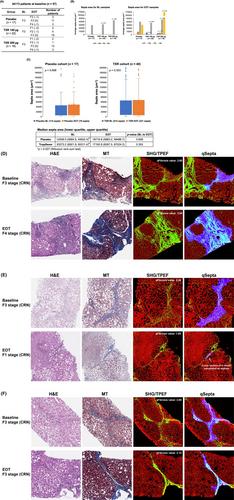Digital quantitation of bridging fibrosis and septa reveals changes in natural history and treatment not seen with conventional histology
Abstract
Background and Aims
Metabolic dysfunction-associated steatohepatitis (MASH) with bridging fibrosis is a critical stage in the evolution of fatty liver disease. Second harmonic generation/two-photon excitation fluorescence (SHG/TPEF) microscopy with artificial intelligence (AI) provides sensitive and reproducible quantitation of liver fibrosis. This methodology was applied to gain an in-depth understanding of intra-stage fibrosis changes and septa analyses in a homogenous, well-characterised group with MASH F3 fibrosis.
Methods
Paired liver biopsies (baseline [BL] and end of treatment [EOT]) of 57 patients (placebo, n = 17 and tropifexor n = 40), with F3 fibrosis stage at BL according to the clinical research network (CRN) scoring, were included. Unstained sections were examined using SHG/TPEF microscopy with AI. Changes in liver fibrosis overall and in five areas of liver lobules were quantitatively assessed by qFibrosis. Progressive, regressive septa, and 12 septa parameters were quantitatively analysed.
Results
qFibrosis demonstrated fibrosis progression or regression in 14/17 (82%) patients receiving placebo, while the CRN scoring categorised 11/17 (65%) as ‘no change’. Radar maps with qFibrosis readouts visualised quantitative fibrosis dynamics in different areas of liver lobules even in cases categorised as ‘No Change’. Measurement of septa parameters objectively differentiated regressive and progressive septa (p < .001). Quantitative changes in individual septa parameters (BL to EOT) were observed both in the ‘no change’ and the ‘regression’ subgroups, as defined by the CRN scoring.
Conclusion
SHG/TPEF microscopy with AI provides greater granularity and precision in assessing fibrosis dynamics in patients with bridging fibrosis, thus advancing knowledge development of fibrosis evolution in natural history and in clinical trials.


 求助内容:
求助内容: 应助结果提醒方式:
应助结果提醒方式:


